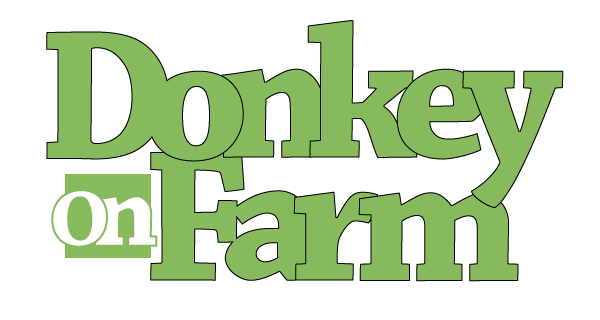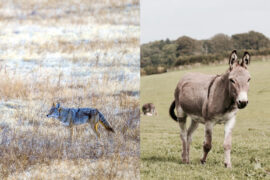A healthy donkey is capable of traveling quickly and carrying way more on its back than a human ever could, but just how fast can a donkey run in order to get these tasks done? Industrialization (which led to mechanization) has largely replaced the donkey, but there are many countries and cultures out there that still rely on this sturdy creature. A donkey is of course slower than a machine, but considering the donkey’s sturdiness, it proves to be more efficient than other livestock such as horses. To answer the question “how fast can a donkey run” we must consider the nature of the donkey as well as what he/she will be used for.
How Fast Can a Donkey Run: Their Nature and Speed
Donkeys have a reputation for being stubborn, but the reality is that most donkeys can move as nicely as a horse if they have a reason to do so. The donkey can, contrary to popular belief, run faster (at the gallop) than most people think. The donkey has different gaits: the walk, trot, and the gallop (this gait being the fastest).
The fastest donkey is the Asiatic wild ass, also known as an onager, but it has never been domesticated. The onager can reach a pace of up to 43 miles per hour (or 70 kilometers per hour). This creature weighs around 500 pounds (230 kilograms) and is the most horse-like in structure, hence the high speed. For comparison, a thoroughbred racing horse can reach the same top speed.
When comparing to horses, however, donkeys are less likely to want to run at a greater speed and will only reach top speed when in sprint. This is because a donkey prefers to think about the situation at hand prior to reacting. A donkey at a gallop is more likely to pace itself at a speed of around 20 to 30 miles per hour (or 32 to 48 kilometers per hour). At the trot (a jog like gait), a donkey can maintain a speed of about 8 to 9 miles per hour (or 13 to 15 kilometers per hour). The trot is the most comfortable “fast” gait for donkeys as they can keep the gait for a longer period of time. In general, donkeys are most likely to choose a slow pace (the walk).
Speed of the Donkey in Relation to Weight
The pace is just one factor when it comes to how fast a donkey can run. What about the moment weight comes into the picture? A donkey can generally carry around 20 to 25 percent of its body weight. In live weight (such as humans), donkeys can carry up to 30 percent of their weight.

In comparison to their Equiade family counterparts, horses, the weight a donkey can carry is quite a bit more. Horses can carry a load of around 20 percent of their body weight. Therefore, a 1000 pound (or 454 kilograms) horse can generally carry around 200 pounds (or 91 kilograms) of weight. Even though when compared to a donkey, the weight a horse can carry is less, donkeys are unable to continue at a faster pace when loaded with their full capacity on their backs.
On average, a donkey that is fully loaded with weight on its back will keep a pace of between 4 to 5 miles per hour (or six to eight kilometers per hour). The pace that a donkey can endure will depend on many factors such as weather, terrain, and his/her physical condition. Thus, the donkey keeps mostly a walking speed when he/she has a load on its back, and will rarely be able to break into more than a trot.
Conclusion
Donkeys can run fast, but they are unlikely to want to do so. So how fast exactly can a donkey run? Donkeys can reach a top speed of about 43 miles per hour (in the case of onager), but these speeds are almost never reached with weight on the animal’s back. On average, a donkey will keep a pace of about 4 to 5 miles per hour when carrying weight. This means that they will nearly always be walking and rarely breaking into a trot. While they may not be best for galloping around a race track, a donkey can carry about 20 to 25 percent of its body weight on its back which proves useful for heavy labored work. Also, the speed that a donkey can reach and the weight he/she can carry largely depends on its physical condition and natural/external factors.

![How Fast Can a Donkey Run? [Or Can They Even Run?] how fast can a donkey run](https://donkeyonfarm.com/wp-content/uploads/2022/04/how-fast-can-a-donkey-run.jpg)

![How Cold is Too Cold for a Donkey? [Plus Tips to Keep Them Warm] How-Cold-is-Too-Cold-for-a-Donkey](https://donkeyonfarm.com/wp-content/uploads/2022/09/How-Cold-is-Too-Cold-for-a-Donkey-270x180.jpg)
![Do Donkeys Laugh? [Plus Why Do They Do It?] do-donkeys-laugh](https://donkeyonfarm.com/wp-content/uploads/2022/08/Why-do-donkeys-laugh-270x180.jpg)
![How to Get Rid of Flies on Your Donkey? [Plus Prevention Methods] How to Get Rid of Flies on your Donkey](https://donkeyonfarm.com/wp-content/uploads/2022/05/How-to-Get-Rid-of-Flies-on-your-Donkey-270x180.jpg)
